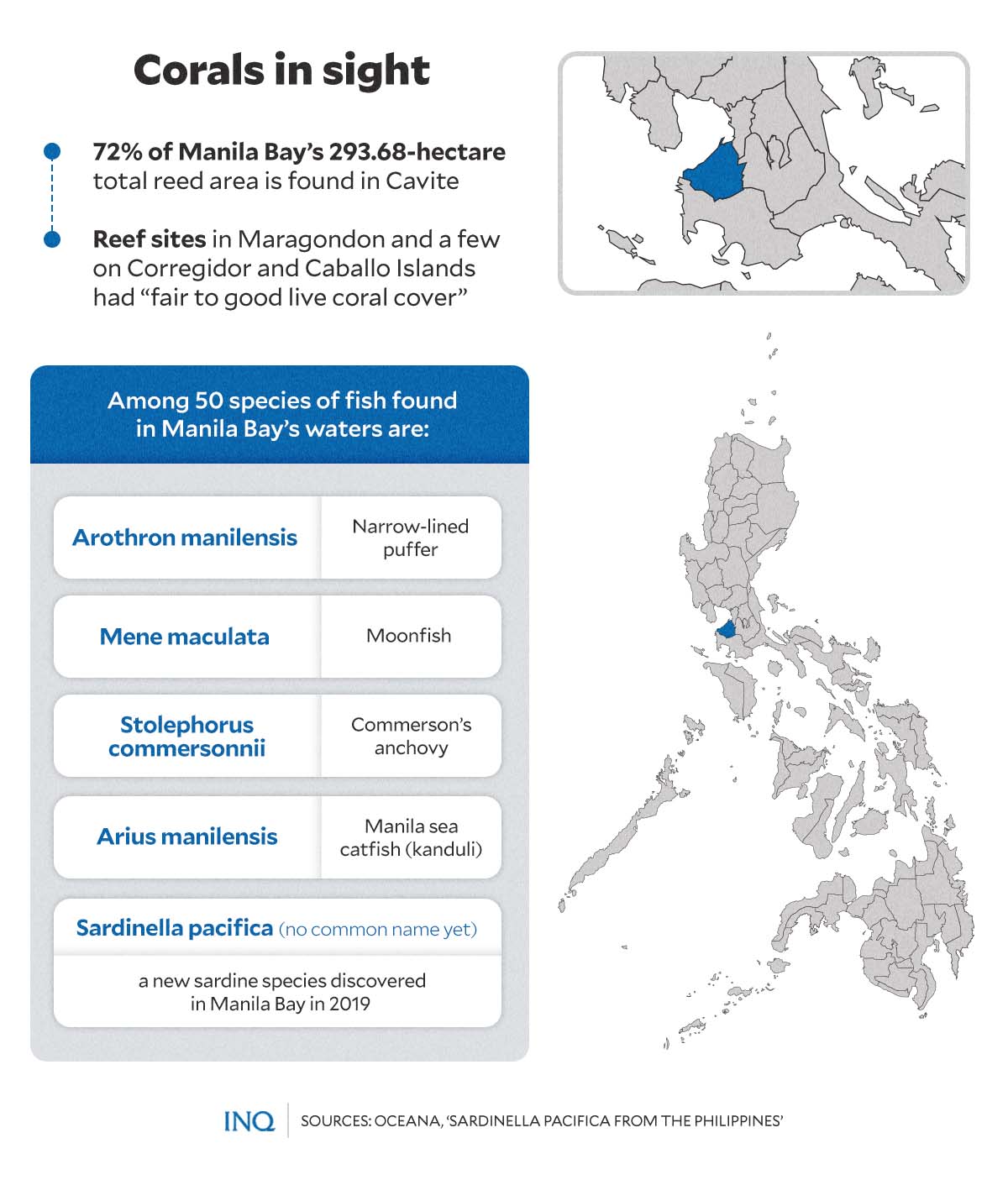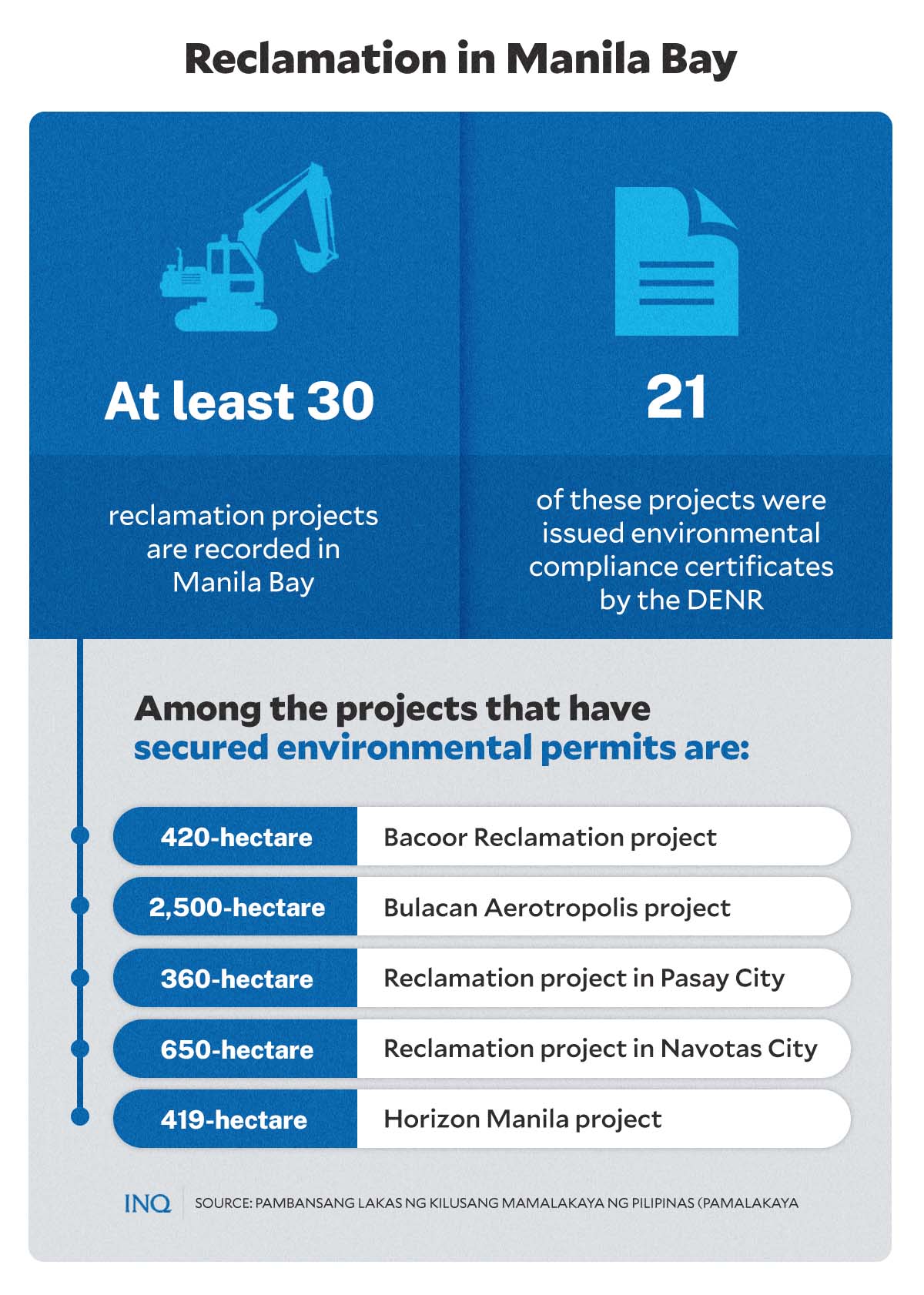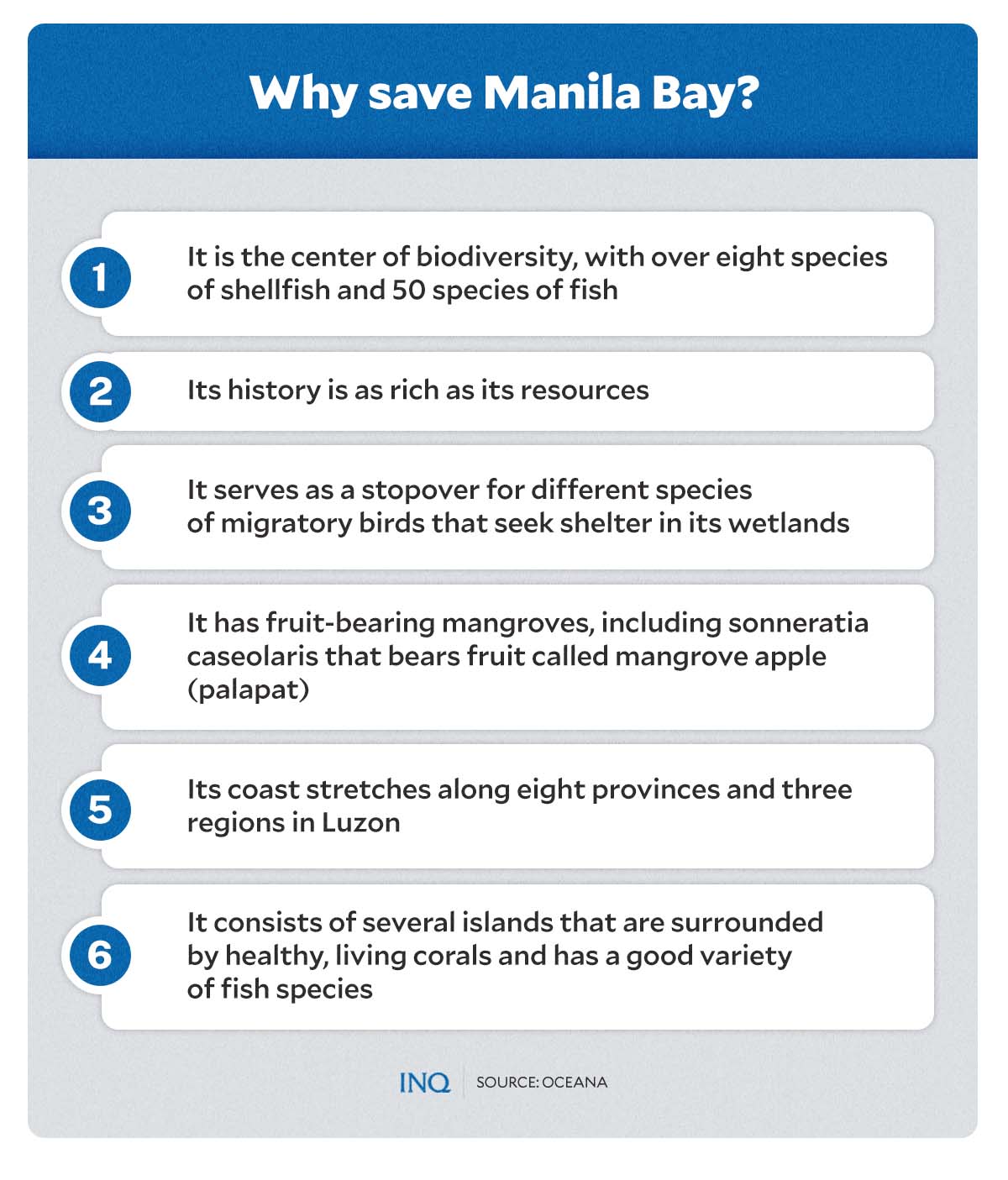Manila Bay not dead, but reclamation killing it, say groups
MANILA, Philippines—Far from what local officials recently claimed that Manila Bay is a “dead body of water,” members of a fisherfolk alliance and a marine conservationist group emphasized that it is alive and well.
In a report published last week, an official of the Department of Environment and Natural Resources (DENR) said that Manila Bay—including the fish in its waters—is already dead due to extreme pollution.
The official explained that tests conducted on the bay’s water found that it had been polluted mainly due to at least 12 oil spills recorded since 2000. These incidents, along with discharges from industries and cargo ships that dock at the port, have increased the presence of oil and grease in the water, the DENR official said.
A study conducted by the DENR fisheries bureau also said it found traces of metals, including copper, cadmium, and zinc coming from the bay’s seabed—and because they have reduced the oxygen in the water, they have made the bay uninhabitable for marine life.
But the militant fishermen’s group Pambansang Lakas ng Kilusang Mamamalakaya ng Pilipinas (Pamalakaya) and Oceana disputed these claims, citing previous studies showing proof that Manila Bay’s ecosystem is not dying.
‘Alive and well’
In a statement, Pamalakaya said that Manila Bay remains diverse with marine resources—with a significant fishing population from Cavite, Metro Manila, Bulacan, and Bataan relying on its fishing grounds.
The fisherfolk group also cited a report by the DENR’s Ecosystems Research and Development Bureau (ERDB), which noted that coral covers are found in the bay’s southern area.
Jose Isidro Michael T. Padin, supervising science research specialist at the ERDB, led the study focusing on an inventory of coral communities in the provinces of Bataan and Cavite. He said that “of the MBA’s total reef area of 293.68 hectares, nearly 72% of the estimated reef area is found in Cavite.”
He added that reef sites in Maragondon, Cavite, and a few on Corregidor and Caballo Islands “had fair to good live coral cover.” However, sedimentation, nutrient contamination, reduced water clarity, and high fishing pressure continue to threaten these reefs.
Local fishers told
Aside from the recent claim made by a DENR official, a report published by the Philippine Daily Inquirer said that local officials have been telling fisherfolk the same narrative about Manila Bay.
On the coast of Limay town in Bataan—the province west of the bay opposite Bulacan province, Metro Manila and Cavite province—barangay officials have previously told fishermen that Manila Bay is already a dead body of water and compared it “to a sewer where you can only get mud.”
However, the fisherfolk community in the area contradicted these claims, saying that they can still catch fish from the bay’s waters—with recent catch including “alubaybay,” a sardine variety that they would salt and dry then sell.
READ: Fishers urged not to venture into Manila Bay, told it’s ‘dead’
Gloria Estenzo-Ramos, an environmental lawyer and vice president of Oceana Philippines, described statements claiming that Manila Bay is dead as sad and highly irresponsible. In a radio interview, she said the bay and its ecosystem are “very much alive.”
According to Oceana, Manila Bay spans 199,400 hectares with a coastline that runs through Cavite, Parañaque, Pasay, Manila, Malabon, Navotas, Bulacan, Pampanga, and Bataan provinces—is a center of biodiversity.
The organization detailed that over eight species of shellfish and 50 species of fish can be found deep in the bay’s waters. Among these wide varieties of fish species include the Sardinella pacifica, a new species discovered in Manila Bay in 2019.
READ: New species of sardines found in Manila Bay; Oceana calls to stop reclamation in the area
The Bureau of Fisheries and Aquatic Resources (BFAR) has also identified Manila Bay as a spawning area of sardines and is still one of the main fishing grounds of artisanal fisherfolk who depend on the sea for their livelihood. Sardines is on top of the kinds of fish caught in the area.
“The government spent a huge amount of money on Manila Bay’s SDP (social development plan). There are mangroves, corals, and seagrass [found there], and Manila Bay is a major source of fish. In what way is it dead?” Ramos said, speaking in Filipino.
“The recent claims on Manila Bay being dead is fake news,” she added.
Ecological threat: Reclamation projects
However, despite acknowledging Manila Bay’s flourishing ecosystem, Pamalakaya warned that numerous ongoing and pending massive reclamation projects in Manila Bay threaten its abundant marine resources.
According to the group, at least 30 reclamation projects are recorded in Manila Bay. Of those, 21 projects—which translates to about 4,000 hectares or nearly double the size of Makati City—have already been issued environmental compliance certificates (ECC) by the DENR.
According to Pamalakaya, among the reclamation projects that got environmental permits from the DENR were:
- 420-hectare Bacoor Reclamation project
- 2,500-hectare Bulacan Aerotropolis project
- 360-hectare reclamation project in Pasay City
- 650-hectare reclamation project in Navotas City
- 419-hectare Horizon Manila project.
On the other hand, data from Oceana citing the Philippine Reclamation Authority showed 23 proposed dump-and-fill projects along Manila Bay.
While various sources provided different figures for the total reclamation projects on Manila Bay, groups agree that these projects are ecological threats that will destroy the fisheries resources in the bay.
READ: Dolomite project just one of many ecological threats seen in Manila Bay
“It can be recalled that we have sought help from the DENR under its current Secretary Maria Antonia Yulo-Loyzaga but to no avail,” said Pamalakaya.
“Instead of discouraging fishers from fishing in Manila Bay, the local government units should support us in demanding concerned government agencies to stop the destructive reclamation and promote genuine rehabilitation,” the group added.
Why save Manila Bay?
In a separate statement, Oceana said large-scale reclamation projects that lead to the dumping and filling of the seas are illegal since these projects violate the people’s constitutional right to a balanced and healthful ecology.
“The dump-and-fill projects hiding behind the promise of reclamation are in pursuit of economic and infrastructure facelift at the expense of the environment and the safety and livelihood of the people,” the organization said.
“Creating land where there was once only water brings irreversible destruction to marine habitats and makes us vulnerable to disasters,” it added.
Previous studies have pointed out that dump-and-fill activities would exacerbate Manila Bay’s vulnerability to environmental hazards and extreme weather events, which are further aggravated by climate change.
Climate change, paired with the environmental threats of illegal reclamation projects, would cause:
- increased rainfall year-round by 2050, which would worsen flooding.
- more frequent super typhoons resulting in storm surges in coastal areas.
- rising sea levels worsening land rapid sinking of the land (land subsidence).
Aside from being a center of biodiversity, Oceana cited other key reasons that Manila Bay must be saved from destructive reclamation projects. Among these were:
- Manila Bay serves as a stopover for different species of migratory birds that seek shelter in its wetlands, particularly the Las Piñas-Parañaque Critical Habitat and Ecotourism Area, where the country’s endemic ducks also seek refuge
- it has fruit-bearing mangroves, including Sonneratia caseolaris whose fruit called mangrove apple (“palapat”) is used to make jams, tarts, candies, vinegar, and as a souring agent in sinigang and paksiw
- it has witnessed historic battles such as the Battles of La Naval de Manila that ended Dutch attempts to seize the Philippines, the Battle of Manila Bay during the Philippine-American War and battles during World War II, wherein the Bay’s fortified islands, like Corregidor, suffered heavy damage
- it consists of several islands surrounded by healthy, living corals and a good variety of fish species.



